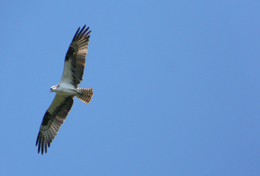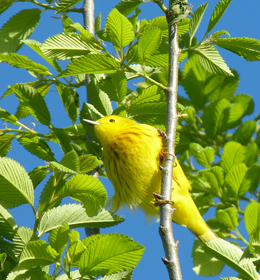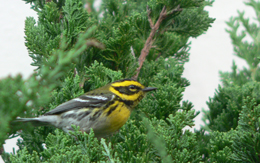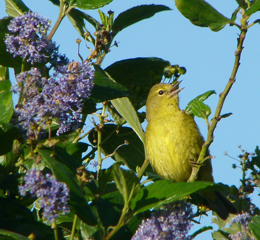Every fall, mainly during the months of September and October, San Francisco gets thousands of avian tourists, on their way from Alaska, British Columbia, Washington, Oregon, and northern California to their wintering grounds in Mexico, Central America, or even South America. Some stay here for months, making San Francisco their winter home. Most just fly over. Many stay for 1, 2 or 3 days before continuing their journey south.

 The largest of these birds are the raptors - hawks, eagles, ospreys, falcons and vultures. Raptors don't like to fly over water so they look for the shortest crossing distance over the Bay. Given the geography of Marin County, that means that most fly between the aptly named Hawk Hill in the Marin Headlands and San Francisco. On a good day, more than 500 raptors are counted soaring over the hill. Up to 19 species - from large birds such as Bald Eagles, Red Tailed Hawks and Ospreys to smaller falcons like the American Kestrel - are seen from Hawk Hill.
The largest of these birds are the raptors - hawks, eagles, ospreys, falcons and vultures. Raptors don't like to fly over water so they look for the shortest crossing distance over the Bay. Given the geography of Marin County, that means that most fly between the aptly named Hawk Hill in the Marin Headlands and San Francisco. On a good day, more than 500 raptors are counted soaring over the hill. Up to 19 species - from large birds such as Bald Eagles, Red Tailed Hawks and Ospreys to smaller falcons like the American Kestrel - are seen from Hawk Hill.
Smaller songbirds also fly over the Golden Gate. Some of these are nocturnal flyers and stop at the nearest good habitat after flying over the water. That's why birders flock to two small birding spots in San Francisco the fall to look for migrating warblers, vireos, flycatchers and other songbirds. You won't find the East Wash (the hill immediately north of the Palace of Legion of Honor and east of the golf course), or the West Wash (the hill north of (behind) the VA Hospital) on any map, but you can usually find birders looking for migrants (birds, that is) at these two spots in the fall.
The small colorful warblers are my favorite migrants. San Francisco is one of the fortunate places in the country with year round warblers. There are two commonly found summer warblers, two winter warblers and five or more additional warbler species that pass through during fall and spring migration. During the summer, the warblers you are most likely to find in San Francisco are the bright Yellow Warbler (an all yellow bird), and the Wilson's Warbler - also yellow, but with a dark black cap. In case you're wondering how birds got their names, the Wilson's Warbler was named after Alexander Wilson, a working class poet born in Scotland in 1766, who was responsible for some of the earliest written work on birds in the United States - 7 volumes of American Ornithology.

The earliest European birders in North America were responsible for virtually all of today's bird names. In the eastern half of the country birds were generally named after places (like the Cape May Warbler), but in the west birds were often named after people. It was considered bad form to name a bird with your own name, so birders named birds for each other.
 For example, Thomas Nuttall, a printer and author of the Manual of the Ornithology of the U.S. and Canada, named the Townsend's Warbler after John Townsend. Townsend was an avid birder, and a taxidermist by trade. He met an unfortunate end - accidentally poisoned by the arsenic used to preserve the skins of animals. The warbler named after Townsend, with its striking yellow and black head pattern, can be found throughout San Francisco in the winter. The picture of the Townsend's Warbler I've included here was taken around the corner from my house on Leavenworth Street.
For example, Thomas Nuttall, a printer and author of the Manual of the Ornithology of the U.S. and Canada, named the Townsend's Warbler after John Townsend. Townsend was an avid birder, and a taxidermist by trade. He met an unfortunate end - accidentally poisoned by the arsenic used to preserve the skins of animals. The warbler named after Townsend, with its striking yellow and black head pattern, can be found throughout San Francisco in the winter. The picture of the Townsend's Warbler I've included here was taken around the corner from my house on Leavenworth Street.
Townsend, in turn, named the Audubon's Warbler (the western version of the aptly named Yellow-Rumped Warbler - San Francisco's other common winter warbler) after John James Audubon, who is probably the best known of all of America's early birders. Like many early birders Audubon collected birds for sketching by shooting them - a practice that is fortunately illegal today. Yellow Rumped Warblers spend their summers in higher elevations (like Yosemite), and the winters on the coast. They are quite bold, and their loud chip identifies them even before they are seen as they flit from tree to tree.
 In addition to our two summer and two winter warblers, five other species of warblers pass through San Francisco in the fall, including the Orange Crowned Warbler, the Nashville Warbler, the Black Throated Gray Warbler, the Hermit Warbler and Macgillivray's Warbler. We also have one species of warbler, the Common Yellowthroat, that can be found all year around in San Francisco, including at Lake Merced.
In addition to our two summer and two winter warblers, five other species of warblers pass through San Francisco in the fall, including the Orange Crowned Warbler, the Nashville Warbler, the Black Throated Gray Warbler, the Hermit Warbler and Macgillivray's Warbler. We also have one species of warbler, the Common Yellowthroat, that can be found all year around in San Francisco, including at Lake Merced.
© Photos by David Assmann